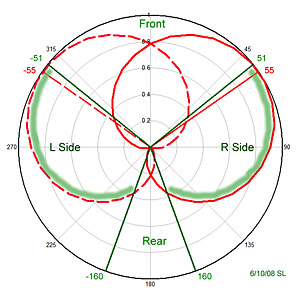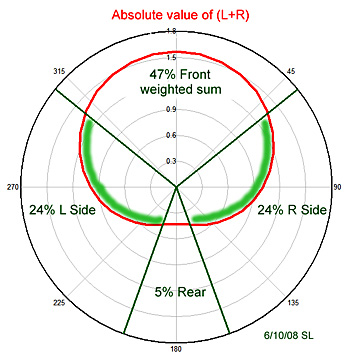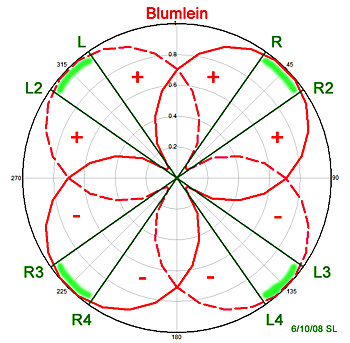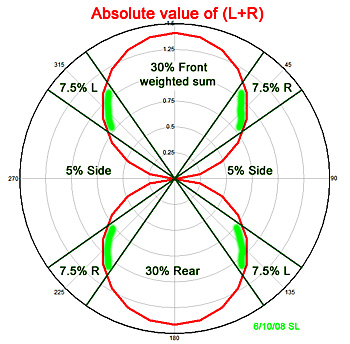Blumlein is an odd child in that it seems the only coincident array that really captures space well to my ear. Of course the imaging is entirely different, but in the spaciousness/ambience department, Blumlein sounds almost more akin to A-B spaced omnis than other coincident or near coincident patterns. I found some Michael Williams AES papers recently and some new material on Stan Linkwitz's website that have helped me understand the technical reason for why it sounds that way to me. It appears that other than spaced omnis, Blumlein has the highest proportion of
stereo reverberation vs mono reverb on playback - meaning the proportion of reverberation that is spread between the playback speakers and not reproduced as a mono source from one speaker or the other. Not to be confused with the direct to reverberant ratio which changes with different patterns and microphone proximity to the source.
Stan Linkwitz's
analysis is here.
Of the entire 360degree ambient field, an ORTF arrangement reproduces 48% of that reverberant field as effectively mono, 'hard-panned' to the speaker positions (48% appears to originate from one speaker or the other on playback), where
Blumlien reproduces just 30% of the reverberant field that way, the remaining 70% of the reverberation is stereo information spread between the speakers.
Here are his polar diagrams (pickup areas reproduced as mono reverberation are marked in green), for ORTF-


and for Blumlein-

 Edit: Here's the significance of the polar plots- All the sound which arrived at the microphone position from within the angles highlighted in green will be reproduced effectively in only one speaker or the other. Reproduction of those regions will be bound to the speaker locations as opposed to emanating from somewhere between them.
Edit: Here's the significance of the polar plots- All the sound which arrived at the microphone position from within the angles highlighted in green will be reproduced effectively in only one speaker or the other. Reproduction of those regions will be bound to the speaker locations as opposed to emanating from somewhere between them.Of the limited number of arrays he takes a look at, Linkwitz mentions that the rear lobe of surpercardioid pattern mics allows them to pick up more stereo reverberation than cardioids and extends this observation to figure-8's, noting the ORTF vs Blumlein stereo reverb percentages I quoted in bold above. Yet he stops short of endorsing the Blumlein array because he is concerned about the folded and reversed imaging of the side and rear pickup quadrants. The supercardioid array he suggests mixes in an additional pair of spaced omnis for reverberant pick-up farther back in the hall.
Interestingly, Williams suggests
intentionally introducing those folded side and reversed rear quadrants for non-Blumlien, multi-channel recordings that are mixed to stereo in his recent 2005 (& 2007) paper below. At the end of the 2005 paper on
acoustic cross-talk in multi-microphone arrays, he outlines a possible improvement on the 2 microphone to 2 channel stereo selection by mixing in the 2 additional rear channels in what he calls a
twisted-quad mixing scheme that looks quite similar to a the rear-lobes of a Blumlien configuration from the reverberant pickup aspect, but avoids the phase reversed sides. Doing so spreads the reverberation and reflections arriving at the mic array from each quadrant of the recording space between the two speakers instead of collapsing everything from the far sides into one speaker or the other, but also reverses the back image in a way similar to Blumlien. The 2007 paper goes on to explore mic array design for inter-format compatibility (using one array to simultaneously record for mono, 2 channel stereo, 3, 4, and 5-channel formats) and suggests using
twisted-quad mixdown to improve on the 2 channel version.
Also consider that everything above only addresses the horizontal plane (though Williams goes farther in his 1991 paper below to analyze the full 3-D space) and although the mono/stereo reverb ratio of a Blumlein pair shouldn't change with elevation, there is still a sensitivity roll-off and null above and below the mics. An omni pair with perhaps similar mono/stereo reverb proportions would be equally sensitive to reverb, early reflections, etc from those quadrants.
Michael William's page with
preprints of his papers and link to Stereo Zoom and Multi-Microphone Array Design tools. In particular-
1991 : 91st AES Convention in New York - Preprint 3155
« Early Reflections and Reverberant Field Distribution in Dual Microphone Stereophonic Sound Recording Systems »2005 : 118th AES Convention in Barcelona: Preprint 6373
«The Whys and Wherefores of Acoustic Cross-talk in Multichannel Microphone Array Design »2007 : 122nd AES Convention in Vienna - Preprint 7057
«Magic Arrays – Multichannel Microphone Array Design Applied to Microphone Arrays Generating Interformat Compatability»Stan Likwitz's page on
recording for stereo.